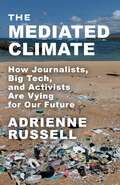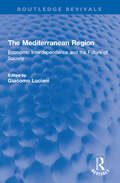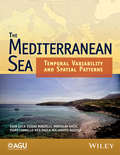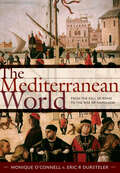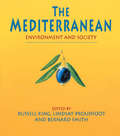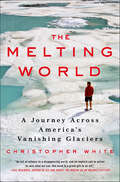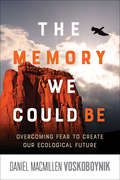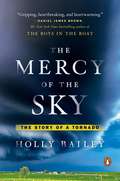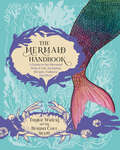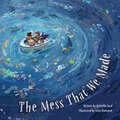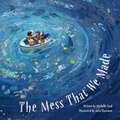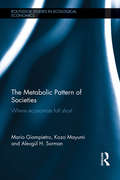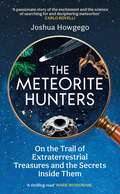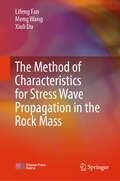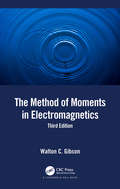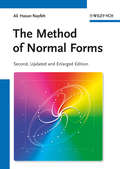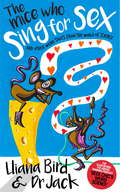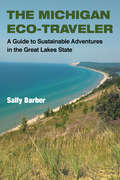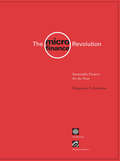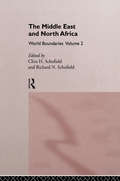- Table View
- List View
The Mediated Climate: How Journalists, Big Tech, and Activists Are Vying for Our Future
by Adrienne RussellTo what extent does journalism deserve blame for the failure to address climate change over the last thirty years? Critics point out that climate coverage has often lacked necessary urgency and hewed to traditional notions of objectivity and balance that allowed powerful interests—mainly fossil fuel companies—to manufacture doubt. Climate journalism, however, developed alongside the digital media landscape, which is characterized by rampant misinformation, political polarization, unaccountable tech companies, unchecked corporate power, and vast inequalities. Under these circumstances, journalism struggled, and bad actors flourished, muddling messages while emissions mounted and societies struggled to avert catastrophe.The Mediated Climate explores the places where the climate and information crises meet, examining how journalism, activism, corporations, and Big Tech compete to influence the public. Adrienne Russell argues that the inadequate response to climate change is intertwined with the profound challenges facing the communications environment. She demonstrates that the information crisis is driven not only by technological changes but also by concentrated power that predates the rise of digital media companies. Efforts to improve climate coverage must take into account the larger social and material contexts in which journalism operates and the broader power dynamics that shape public discourse. Drawing on interviews with journalists and activists, Russell considers the ways recent movements are battling misinformation. She offers timely recommendations to foster engagement with climate issues and calls on readers to join in efforts to reshape the media landscape to better serve the public interest.
The Medieval Peutinger Map
by Emily AlbuThe Peutinger Map remains the sole medieval survivor of an imperial world-mapping tradition. It depicts most of the inhabited world as it was known to the ancients, from Britain's southern coastline to the farthest reaches of Alexander's conquests in India, showing rivers, lakes, islands, and mountains while also naming regions and the peoples who once claimed the landscape. Onto this panorama, the mapmaker has plotted the ancient Roman road network, with hundreds of images along the route and distances marked from point to point. This book challenges the artifact's self-presentation as a Roman map by examining its medieval contexts of crusade, imperial ambitions, and competition between the German-Roman Empire and the papacy.
The Mediterranean Region: Economic Interdependence and the Future of Society (Routledge Revivals)
by Giacomo LucianiFirst published in 1984, The Mediterranean Region considers the broad economic and political problems facing the region from a variety of perspectives. The book features the work of international experts on the Mediterranean region. It discusses the changing legal environment and covers the Law of the Sea as applied to the Mediterranean, and the position of the Arab countries in the region. Chapters are also devoted to exploring the different policies of Russia, the United States, and Europe, towards the Mediterranean. The Mediterranean Region is a detailed contribution to research and understanding of the area.
The Mediterranean Sea: Temporal Variability and Spatial Patterns
by Gianluca Eusebi Borzelli Piero Lionello Miroslav Gacic Paola Malanotte-RizzoliSurface, intermediate, and deep-water processes and their interaction in time and space drive the major ocean circulation of the Mediterranean Sea. All major forcing mechanisms, such as surface wind forcing, buoyancy fluxes, lateral mass exchange, and deep convection determining the global oceanic circulation are present in this body of water. Deep and intermediate water masses are formed in different areas of the ocean layers and they drive the Mediterranean thermohaline cell, which further shows important analogies with the global ocean conveyor belt. The Mediterranean Sea: Temporal Variability and Spatial Patterns is a comprehensive volume that investigates the temporal and spatial variability patterns in the ocean basin. The Mediterranean Sea will be a valuable resource for geoscientists, oceanographers, and meteorologists.
The Mediterranean World: From the Fall of Rome to the Rise of Napoleon
by Eric R Dursteler Monique O'ConnellA history of this hub of culture and commerce: &“Enviable readability . . . an excellent classroom text.&” —European History Quarterly Located at the intersection of Asia, Africa, and Europe, the Mediterranean has connected societies for millennia, creating a shared space of intense economic, cultural, and political interaction. Greek temples in Sicily, Roman ruins in North Africa, and Ottoman fortifications in Greece serve as reminders that the Mediterranean has no fixed national boundaries or stable ethnic and religious identities. In The Mediterranean World, Monique O&’Connell and Eric R. Dursteler examine the history of this contested region from the medieval to the early modern era, beginning with the fall of Rome around 500 CE and closing with Napoleon&’s attempted conquest of Egypt in 1798. Arguing convincingly that the Mediterranean should be studied as a singular unit, the authors explore the centuries when no lone power dominated the Mediterranean Sea and invaders brought their own unique languages and cultures to the region. Structured around four interlocking themes—mobility, state development, commerce, and frontiers—this book, including maps, photos, and illustrations, brings new dimensions to the concepts of Mediterranean nationality and identity.
The Mediterranean: Environment and Society (Liverpool University Press Ser.)
by Russell King Bernard Smith Lindsay ProudfootThis book addresses contemporary geographical issues in the Mediterranean Basin from a perspective that recognizes the physical characteristics and cultural interactions which link the different Mediterranean states as a recognisable geographic entity. Sixteen chapters each deal with a major geographical issue currently facing the Mediterranean, each providing an invaluable summary of the extensive but widely dispersed literature relating to Mediterranean issues. Particular emphasis is placed on the interaction between society and environment in terms of environmental management, differential regional development and its associated political, demographic, cultural and economic tensions.
The Melting World: A Journey Across America's Vanishing Glaciers
by Christopher WhiteGlobal warming usually seems to happen far away, but one catastrophic effect of climate change is underway right now in the Rocky Mountains. In The Melting World, Chris White travels to Montana to chronicle the work of Dan Fagre, a climate scientist and ecologist, whose work shows that alpine glaciers are vanishing rapidly close to home. For years, Fagre has monitored the ice sheets in Glacier National Park proving that they—and by extension all Rocky Mountain ice—will melt far faster than previously imagined. How long will the ice fields survive? What are the consequences on our environment? The Melting World chronicles the first extinction of a mountain ecosystem in what is expected to be a series of such global calamities as humanity faces the prospect of a world without alpine ice.
The Memory We Could Be: Overcoming Fear to Create Our Ecological Future
by Daniel Macmillen Voskoboynik“Voskoboynik’s book offers an exhilarating introduction to our ecological crisis, what caused it, and how we can imagine a better future.” —Jason Hickel, author of Less Is MoreThe Memory We Could Be moves beyond the sterile, technical language around climate change and ecology to humanize the abstraction of global warming and bring different voices into the conversation.Drawing on sources from anthropology to hydrology, botany to economics, agronomy to astrobiology, medicine to oceanography, physics to history, the author weaves a lyrical and powerful story of our relationship with nature.The book has three parts:“Past” addresses memory. Our inability to comprehend our staggering present partly lies in our ignorance of our staggering past. We peer into the black box of history to understand how we got here. We go on a journey across the roots of our ecological crisis, from the Roman Empire to the forests of Burma, from Congolese rubber plantations, to Colombian oil fields.“Present” illustrates how climate change is shaping our world today, explores how it relates to poverties and inequalities, and equips readers with a set of intuitive instruments to understand climate impacts.“Future” looks at alternatives and strives to illustrate in human terms the world we could lose and the world we can win. It asks what we can do and develops a transformative vision of a more ecological and equitable economy.The Memory We Could Be is vital reading for all of humanity.“A gripping review of where we’ve been, where we are, and where we may be headed.” —Michael E. Mann, author of The New Climate War
The Men of the Last Frontier
by Grey Owl James PolkIn 1931 Grey Owl published his first book, The Men of the Last Frontier, a work that is part memoir, part history of the vanishing wilderness in Canada, and part compendium of animal and First Nations tales and lore. A passionate, compelling appeal for the protection and preservation of the natural environment pervades Grey Owls words and makes his literary debut still ring with great relevance in the 21st century. By the 1920s, Canadas outposts of adventure had been thrust farther and farther north to the remote margins of the country. Lumbermen, miners, and trappers invaded the primeval forests, seizing on natures wealth with soulless efficiency. Grey Owl himself fled before the assault as he witnessed his valleys polluted with sawmills, his hills dug up for hidden treasure, and wildlife, particularly his beloved beavers, exterminated for quick fortunes.
The Mercy of the Sky
by Holly BaileyAn acclaimed national reporter returns to her hometown to give an inside account of the deadly tornado that hit Moore, Oklahoma, in May 2013--a dramatic, suspenseful story of human courage in the face of natural disaster. Oklahomans have long been known for their fatalism and grit, but even old-timers are troubled by the twisters that are devastating the state with increasing frequency. On May 20, 2013, the worst tornado on record landed a direct hit on the small town of Moore, destroying two schools while the children cowered inside. Oklahoma native Holly Bailey grew up dreaming of becoming a storm chaser. Instead, she became Newsweek's youngest ever White House correspondent, traveling to war zones with Presidents Bush and Obama. When Moore was hit, Bailey went back both as a journalist and a hometown girl, speaking to the teachers who put their lives at risk to save their students, the weathermen more revered than rock stars and more tormented than they let on, and many shell-shocked residents. In The Mercy of the Sky Bailey does for the Oklahoma flatlands what Sebastian Junger did for Gloucester, Massachusetts, in The Perfect Storm, telling a dramatic, page-turning story about a town that must survive the elements--or die.From the Hardcover edition.
The Mercy of the Sky: The Story of a Tornado
by Holly Bailey"A gripping, heartbreaking and heartwarming account of the monster tornado that ravaged Moore, Oklahoma in 2013. It will leave you emotionally drained but glad you journeyed into the heart of this extraordinary storm with Bailey as your guide." --Daniel James Brown, #1 NY Times bestselling author of The Boys in the Boat Winner of the Oklahoma Book Award// Winner of the American Meteorological Society's Louis J. Battan Award An acclaimed reporter returns to her hometown after the worst twister on record and emerges with a suspenseful story of human courage in the face of natural disaster. On May 20, 2013, the worst tornado on record landed a direct hit on the town of Moore, on the outskirts of Oklahoma City, levelling neighborhoods, sending farm animals flying, and destroying a school while the children cowered inside. Holly Bailey went back both as a journalist and a hometown girl, speaking to the teachers who put their lives at risk as they struggled to comfort their students; to the mayor and first responders who waded through the debris while the storm still raged; to the scientists and meteorologists who have dedicated their lives to understanding tornadoes but still can't determine when one will land with any degree of certainty and are haunted by every death they might have prevented; to the storm chasers who pursue level 5 twisters with a combination of gadgetry, courage and adrenaline; and to the shell shocked residents of Moore, who rose to the occasion that day with countless acts of selfless courage. An intense and inspiring account of what happened on that fateful day, The Mercy of the Sky Bailey does for the Oklahoma flatlands what Sebastian Junger did for Gloucester, Massachusetts, in The Perfect Storm, telling the dramatic story of a town that must survive the elements--or die. "The book is excellent - well researched, well told, with a strong narrative that reads like a disaster novel... It's difficult to imagine that anyone other than an Okie could tell the story so confidently and so well." - The Oklahoman "This gripping book tells the story of one resilient Oklahoma town and the immense killer tornado that ripped through it. Holly Bailey brings together riveting science, human drama, courage, tragedy, and redemption to create a quintessential American story. Powerful and moving." - Douglas Presenton, #1 New York Times bestselling co-author of The Monster of Florence "Bailey is a brilliant storyteller. She brings you to the center of the storm - and it's terrifying. She makes you feel a community's loss - and it's devastating. And she brings you inside people's lives as they heal - and it's inspiring." - David Greene, host of NPR's Morning EditionFrom the Hardcover edition.
The Mermaid Handbook: A Guide to the Mermaid Way of Life, Including Recipes, Folklore, and More
by Taylor Widrig Briana Corr Scott&“Contains profiles of mermaids from around the world complete with folklore about each maiden . . . a must-have if you are fascinated with mermaids.&” —BeachcombingThe book mermaids-in-training have been waiting for. From history and folklore to recipes and tips for ocean preservation, as well as profiles and original illustrations of mer-maidens from around the world, The Mermaids Handbook features everything you need to know to follow the mermaid way of life.]Over 40 healthy and accessible recipes, developed by author Taylor Widrig of Mermaid Fare, a Nova Scotia–based company specializing in wild and cultivated sea vegetables, include scrumptious starters like Mermaid Kaiso Seaweed Salad, new classics like Dulse, Lettuce, and Tomato Sandwich and Creamy Wakame Casserole, as well as healthy snacks like Smoothie Bowls and Energy Bites, and even homemade beauty products, such as the Coconut Sea Hair Mask—for that salty sea-hair.Includes an introduction by Dr. Alan Critchley with everything you&’ve ever wanted to know about seaweeds and original 2-colour illustrations by artist Briana Corr Scott (The Book of Selkie).&“Nova Scotia sea-vegetable advocate Taylor Widrig is hoping to lure a new generation into the depths with her debut book . . . Written in a conversational tone, Widrig&’s scientific explanations are fascinating and age appropriate.&” —Quill & Quire
The Mess That We Made
by Michelle LordThe Mess That We Made explores the environmental impact of trash and plastic on the ocean and marine life, and it inspires kids to do their part to combat pollution. Simple, rhythmic wording builds to a crescendo ("This is the mess that we made. These are the fish that swim in the mess that we made.") and the vibrant digital artwork captures the disaster that is the Great Pacific Garbage Patch. Children can imagine themselves as one of the four multi-ethnic occupants of the little boat surrounded by swirling plastic in the middle of the ocean, witnessing the cycle of destruction and the harm it causes to plants, animals, and humans. The first half of the book portrays the growing magnitude of the issue, and the second half rallies children and adults to make the necessary changes to save our oceans. Facts about the Great Pacific Garbage Patch, ocean pollution, and how kids can help are included in the back matter.
The Mess That We Made
by Michelle LordThe Mess That We Made explores the environmental impact of trash and plastic on the ocean and marine life, and it inspires kids to do their part to combat pollution. Simple, rhythmic wording builds to a crescendo ("This is the mess that we made. These are the fish that swim in the mess that we made.") and the vibrant digital artwork captures the disaster that is the Great Pacific Garbage Patch. Children can imagine themselves as one of the four multi-ethnic occupants of the little boat surrounded by swirling plastic in the middle of the ocean, witnessing the cycle of destruction and the harm it causes to plants, animals, and humans. The first half of the book portrays the growing magnitude of the issue, and the second half rallies children and adults to make the necessary changes to save our oceans. Facts about the Great Pacific Garbage Patch, ocean pollution, and how kids can help are included in the back matter.
The Metabolic Pattern of Societies: Where Economists Fall Short (Routledge Studies In Ecological Economics Ser. #15)
by Mario Giampietro Kozo Mayumi Alevgül H. SormanIt is increasingly evident that the conventional scientific approach to economic processes and related sustainability issues is seriously flawed. No economist predicted the current planetary crisis even though the world has now undergone five severe recessions primed by dramatic increases in the price of oil. This book presents the results of more than twenty years of work aimed at developing an alternative method of analysis of the economic process and related sustainability issues: it is possible to perform an integrated and comprehensive analysis of the sustainability of socio-economic systems using indicators and variables that have been so far ignored by conventional economists. The book’s innovative approach aims to provide a better framework with which we can face the predicaments of sustainability issues. It begins by presenting practical examples of the shortcomings of conventional economic analysis and examines the systemic problems faced when trying to use quantitative analysis for governance. In providing a critical appraisal of current applications of economic narratives to the issue of sustainability, the book presents several innovative concepts required to generate a post-Newtonian approach to quantitative analysis in the Musiasem approach. An empirical section illustrates the results of an analysis of structural changes in world and EU countries. Finally, the book, using the insight gained in the theoretical and empirical analysis, exposes the dubious quality of many narratives currently used in the sustainability debate. Overall, the performance of modern economies across different hierarchical levels of organization and across different disciplinary knowledge systems is fully analyzed and a more realistic measure of happiness and well-being is devised. The book should be of interest to researchers and students looking at the issue of sustainability within a variety of disciplines.
The Metallurgy of Roman Silver Coinage
by Kevin Butcher Jane Evans Vanessa Pashley Matthew Ponting Christopher Somerfield Kevin Butcher Matthew Ponting Jane Evans Vanessa Pashley Christopher SomerfieldThe fineness of Roman imperial and provincial coinage has been regarded as an indicator of the broader fiscal health of the Roman Empire, with the apparent gradual decline of the silver content being treated as evidence for worsening deficits and the contraction of the supply of natural resources from which the coins were made. This book explores the composition of Roman silver coinage of the first century AD, re-examining traditional interpretations in the light of an entirely new programme of analyses of the coins, which illustrates the inadequacy of many earlier analytical projects. It provides new evidence for the supply of materials and refining and minting technology. It can even pinpoint likely episodes of recycling old coins and, when combined with the study of hoards, hints at possible strategies of stockpiling of metal. The creation of reserves bears directly on the question of the adequacy of revenues and fiscal health.
The Meteorite Hunters: On the Trail of Extraterrestrial Treasures and the Secrets Inside Them
by Joshua HowgegoWant to join the ultimate cosmic treasure hunt? 'They fall from the sky, and tell us about the universe: a passionate story of the excitement and the science of searching for and deciphering meteorites.' Carlo Rovelli Meteors, with their ethereal, glowing trails slashing through the atmosphere, have entranced us for centuries. But these extraterrestrial visitors are also inestimably valuable. Not just for collectors, who can make their fortunes tracking them down, but for scientists too. Meteorites are the most ancient objects we know, unblemished time capsules from the birth of the solar system. Following in the footsteps of passionate hobbyists, ground-breaking scientists and intrepid adventurers, Joshua Howgego takes a rollicking ride through the world of meteorite hunting. Join the seasoned practitioners braving the elements as they scour the Sahara and ice sheets of Antarctica. Discover how, closer to home, one unlikely hero – a self-taught jazz guitarist – is uncovering the countless micrometeorites scattered across the rooftops of our cities. And meet the professor searching for the rarest of the rare: fossil meteorites, entombed in rock since the days of the dinosaurs. Finding these stones from space is just the beginning. As scientists tease out their secrets, they piece together an unexpected new history of the solar system, with implications that extend to one of the most fundamental questions we can ask: how did life on earth begin?
The Method of Characteristics for Stress Wave Propagation in the Rock Mass
by Meng Wang Xiuli Du Lifeng FanThis book is written by subject experts based on the latest research results on the characteristic line method of stress wave propagation in rock masses. It establishes a framework for stress wave propagation analysis methods under three levels of rocks, joints and rock masses. It introduces the two-characteristic line method for stress wave propagation in rocks, and further illustrates the modified characteristic line method for stress wave propagation in complex jointed rock masses. The split three-characteristic line method was proposed for stress wave propagation in rock masses with macro-joints and micro-defects. The book focuses on the basic theory, and highlights the ideas, methods and steps to solve the problem of stress wave propagation in rock masses. This book can be used as a reference book for researchers of research institutes engaged in analyzing, predicting and controlling dynamic stability in rock, geological, and mining engineering.
The Method of Moments in Electromagnetics
by Walton C. GibsonThe Method of Moments in Electromagnetics, Third Edition details the numerical solution of electromagnetic integral equations via the Method of Moments (MoM). Previous editions focused on the solution of radiation and scattering problems involving conducting, dielectric, and composite objects. This new edition adds a significant amount of material on new, state-of-the art compressive techniques. Included are new chapters on the Adaptive Cross Approximation (ACA) and Multi-Level Adaptive Cross Approximation (MLACA), advanced algorithms that permit a direct solution of the MoM linear system via LU decomposition in compressed form. Significant attention is paid to parallel software implementation of these methods on traditional central processing units (CPUs) as well as new, high performance graphics processing units (GPUs). Existing material on the Fast Multipole Method (FMM) and Multi-Level Fast Multipole Algorithm (MLFMA) is also updated, blending in elements of the ACA algorithm to further reduce their memory demands. The Method of Moments in Electromagnetics is intended for students, researchers, and industry experts working in the area of computational electromagnetics (CEM) and the MoM. Providing a bridge between theory and software implementation, the book incorporates significant background material, while presenting practical, nuts-and-bolts implementation details. It first derives a generalized set of surface integral equations used to treat electromagnetic radiation and scattering problems, for objects comprising conducting and dielectric regions. Subsequent chapters apply these integral equations for progressively more difficult problems such as thin wires, bodies of revolution, and two- and three-dimensional bodies. Radiation and scattering problems of many different types are considered, with numerical results compared against analytical theory as well as measurements.
The Method of Normal Forms
by Ali H. NayfehIn this introductory treatment Ali Nayfeh presents different concepts from dynamical systems theory and nonlinear dynamics in a rigorous yet plan way. He systematically introduces models and techniques and states the relevant ranges of validity and applicability. The reader is provided with a clear operational framework for consciously use rather than focused on the underlying mathematical apparatus. The exposition is largely by means of examples, dealt with up to their final outcome. For most of the examples, the results obtained with the method of normal forms are equivalent to those obtained with other perturbation methods, such as the method of multiple scales and the method of averaging. The previous edition had a remarkable success by researchers from all over the world working in the area of nonlinear dynamics and their applications in engineering. Additions to this new edition concern major topics of current interest. In particular, the author added three new chapters dedicated to Maps, Bifurcations of Continuous Systems, and Retarded Systems. In particular the latter has become of major importance in several applications, both in mechanics and in different areas. Accessible to engineers and applied scientist involved with nonlinear dynamics and their applications in a wide variety of fields. It is assumed that readers have a knowledge of basic calculus as well as the elementary properties of ordinary-differential equations.
The Mice Who Sing For Sex: And Other Weird Tales from the World of Science
by Lliana Bird Dr Jack LewisLliana Bird and Dr Jack Lewis tackle the strange and surreal phenomena from the depths of the oceans to the limits of the far flung universe; the dark corners of your laundry basket to the forgotten compartments of your fridge. Packed with unusual facts and stories of the absurd each of the fascinating insights is told with the Geek Chic team's inimitable humour and wit.An hilarious exploration all things bizarre from the world of science, The Mice Who Sing for Sex takes on weighty issues including heavy metal loving sharks, life-threatening skinny jeans, our impending jellyfish apocalypse and of course, the singing mice of the title.
The Mice Who Sing For Sex: And Other Weird Tales from the World of Science
by Jack Lewis Lliana BirdLliana Bird and Dr Jack Lewis tackle the strange and surreal phenomena from the depths of the oceans to the limits of the far flung universe; the dark corners of your laundry basket to the forgotten compartments of your fridge. Packed with unusual facts and stories of the absurd each of the fascinating insights is told with the Geek Chic team's inimitable humour and wit.An hilarious exploration all things bizarre from the world of science, The Mice Who Sing for Sex takes on weighty issues including heavy metal loving sharks, life-threatening skinny jeans, our impending jellyfish apocalypse and of course, the singing mice of the title.
The Michigan Eco-Traveler: A Guide to Sustainable Adventures in the Great Lakes State
by Sally BarberMichigan offers some of the most wonderfully diverse recreation opportunities in the country. The Michigan Eco-Traveleris for a new and growing breed of leisure traveler and adventurer--the individual seeking to experience the pleasant peninsulas responsibly by minimizing his or her eco-footprint. The book introduces readers to the importance of eco-friendly travel and highlights some of the best eco-conscience venues across the state that offer activities from golfing to skiing to sailing and much more. The book also examines environmental pressures on the state's recreational resources, revealing the critical need for joining together in conservation practices, and offers travelers helpful tips for evaluating the sustainability of their own favorite recreational spots. Whether you're a weekend traveler, extreme adventurer, or family on vacation, The Michigan Eco-Travelerlights the way to a greener getaway. Naturalists, conservationists, and hospitality experts will find the book equally helpful in responding to the ever rising demand for sustainable recreation.
The Microfinance Revolution: Sustainable Finance for the Poor
by Marguerite RobinsonAround the world, a revolution is occurring in finance for low-income people. The microfinance revolution is delivering financial services to the economically active poor on a large scale through competing, financially self-sufficient institutions. In a few countries this has already happened; in others it is under way. The emerging microfinance industry has profound implications for social and economic development. For the first time in history, capital is well on its way to being democratized. 'The Microfinance Revolution', in three volumes, is aimed at a diverse readership - economists, bankers, policymakers, donors, and social scientists; microfinance practitioners and specialists in local finance and rural and urban development; and members of the general public interested in development. This first volume, 'Sustainable Finance for the Poor', focuses on the shift from government- and donor-subsidized credit systems to self-sufficient microfinance institutions providing voluntary savings and credit services.
The Middle East and North Africa: World Boundaries Volume 2 (World Boundaries Series #Vol. 2)
by Clive H. Schofield Richard N. SchofieldMiddle East and North Africa brings together some of today's most influential analysts of a region which from colonial times to the present has seen great territorial change.
